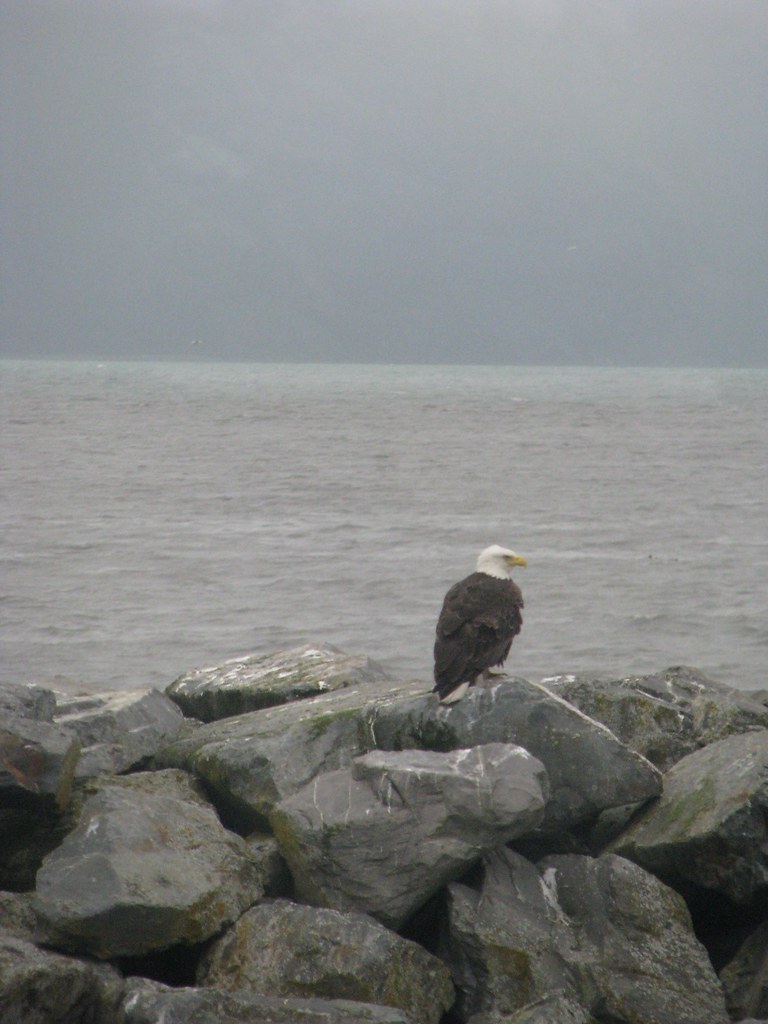Most people probably drive down to Alaska’s Kenai Peninsula for the scenery and the wildlife, and that’s also true for me. Sure, I enjoyed poking around some of the more unusual aspects of Kenai geography but that doesn’t mean I haven’t taken advantage of opportunities to marvel at the natural beauty that attracts every other tourist to this region.
I’ll focus on some of the wildlife I’ve observed in today’s posting.
It’s impossible to avoid contact with wild critters of every stripe down here. Stay far away from the Kenai if you have an unnatural fear of large animals. They are everywhere on the land, in the sea and in the air. They cannot be avoided. Most people would consider that a benefit, and so do I.
Humpback Whale

I ventured onto the obligatory half-day cruise out of Seward into Kenai Fjords National Park along with a horde of tourists from a cruise ship port of call on a picture-perfect day. Honestly, we’ve had amazing weather this trip with only a single rainy morning the day we traveled to Whittier. Everyone we met who lives here says this has been an exceptionally cold summer with constant rain. We’re lucky to hit a dry, sunny patch. Coastal Alaska is noted for its abundant rainfall and we’d planned accordingly. We’ve been pleasantly surprised.
Can you believe I actually shot this image of a juvenile humpback whale breaching? Don’t be fooled, I am not a nature photographer. This took about thirty attempts of blurred images, near misses and random whale body parts to capture.
We’d sailed out to see the glaciers and headed back along the shallow coves of Aialik Bay’s western shore (map). The captain spotted a spout far in the distance. We crept slowly towards the target, expecting to see another tail fin or perhaps an arched back like we’d already experienced several times earlier in the day. Instead we found a young humpback whale cavorting with their mother; breaching, rolling, and behaving like a child of any species. Mama rolled, nuzzled and slapped her fins encouragingly while junior frolicked and played nearby. This went on for about twenty minutes. I figured it was something unusual when I noticed the ship’s crew grabbing their cameras.
Moose

Moose live everywhere accessible on the Kenai. Frequent road signs warn drivers to remain on the lookout to avoid serious injury to moose and human alike. We’ve seen moose tracks constantly with plenty of evidence of foraging. We just haven’t seen many actual moose. I guess that’s probably because we hike with our own brand of wildlife repellent: a four-year-old and an eight-year-old, with a constant stream-of-consciousness banter going on between them. Indigenous creatures know we’re coming from a mile away and give us wide berth.
That’s probably why we haven’t seen a wild bear either and I’m perfectly happy to skip a wildlife encounter of that variety. We saw plenty of bears safely behind a fence at the Alaska Wildlife Conservation Center and that’s good enough for me. The kids, who compiled their own list of animals they wanted to see during their visit, say that “counts.” What a relief!
Our up-close moose encounter actually took place in the middle of town during broad daylight. Mother and child moose foraged along the roadside in a residential area, right in somebody’s front yard. We pulled our car over onto a wide shoulder and watched them graze for awhile. This image was the best of my collection of moose-butt photos. I can’t seem to convince the wildlife to stop, turn around, and smile for the camera.
Bald Eagle

It’s exciting to view an American Bald Eagle, such an iconic symbol of the United States. This doesn’t happen very often back home in the Lower 48. However they’re practically as common as pigeons up here in Alaska. I got a chill the first few times. Now I’ve almost become blasé: “oh yeh, another bald eagle, yawn.” They are amazingly easy to spot. The white patch is a dead giveaway that appears from great distances.
Mountain Goat

A mountain goat, by contrast, is something I’ve never seen in the wild before and I’ve spotted only this one specimen. The Kenai and Chugach Mountains, where I’m spending my time, are right at the northern fringe of the mountain goat range. Generally they confine themselves to the very highest terrain above the treeline. That makes them a tad difficult to spot or photograph, at least by me, because I spend most of my time safely down in the valleys. For some unknown reason this guy decided to descend from his usual alpine habitat so I could get a good, close view.
Sea Lions

Steller Sea Lions inhabit various rocky outcrops along the coastal North Pacific. I don’t know what makes one rock any better than the others but the sea lions seem to have a innate understanding. There will be a hundred stony shelves all seemingly equal to my untrained eye. Nonetheless the sea lions always congregate on the same one. Maybe fish school there, maybe the sun is a little warmer, maybe it’s tradition. Regardless, there they were, hanging out on the rock with no particular concerns.

Leave a Reply